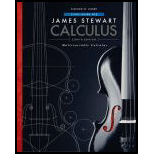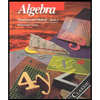
Study Guide for Stewart's Multivariable Calculus, 8th
8th Edition
ISBN: 9781305271845
Author: Stewart, James
Publisher: Brooks Cole
expand_more
expand_more
format_list_bulleted
Concept explainers
Textbook Question
Chapter 15.4, Problem 4PT
True or False:
For f(x, y) = x2(x + y), x and y are independent variables.
Expert Solution & Answer
Trending nowThis is a popular solution!

Chapter 15 Solutions
Study Guide for Stewart's Multivariable Calculus, 8th
Ch. 15.1 - Prob. 1PTCh. 15.1 - Prob. 2PTCh. 15.1 - Let R={(x,y)|3x5,2y4}andf(x,y)=y2x2.For every...Ch. 15.1 - Sometimes, Always, or Never: Rf(x,y)dA is the...Ch. 15.1 - Prob. 5PTCh. 15.1 - Prob. 6PTCh. 15.1 - Prob. 7PTCh. 15.1 - Prob. 8PTCh. 15.2 - Prob. 1PTCh. 15.2 - Prob. 2PT
Ch. 15.2 - Prob. 3PTCh. 15.2 - Prob. 4PTCh. 15.3 - Prob. 1PTCh. 15.3 - Prob. 2PTCh. 15.4 - Prob. 1PTCh. 15.4 - Prob. 2PTCh. 15.4 - Prob. 3PTCh. 15.4 - True or False: For f(x, y) = x2(x + y), x and y...Ch. 15.5 - Prob. 1PTCh. 15.6 - Prob. 1PTCh. 15.6 - Prob. 2PTCh. 15.6 - EzdV, where E is the wedge-shaped solid shown at...Ch. 15.6 - Prob. 4PTCh. 15.7 - Prob. 1PTCh. 15.7 - Prob. 2PTCh. 15.7 - Prob. 3PTCh. 15.7 - Prob. 4PTCh. 15.8 - Prob. 1PTCh. 15.8 - Prob. 2PTCh. 15.8 - Prob. 3PTCh. 15.8 - Prob. 4PTCh. 15.9 - Find the Jacobian for x = u2v2, y = u2 + v2. a)...Ch. 15.9 - Find the iterated integral for RdA, where R is the...
Knowledge Booster
Learn more about
Need a deep-dive on the concept behind this application? Look no further. Learn more about this topic, calculus and related others by exploring similar questions and additional content below.Similar questions
Recommended textbooks for you
 Algebra for College StudentsAlgebraISBN:9781285195780Author:Jerome E. Kaufmann, Karen L. SchwittersPublisher:Cengage Learning
Algebra for College StudentsAlgebraISBN:9781285195780Author:Jerome E. Kaufmann, Karen L. SchwittersPublisher:Cengage Learning College Algebra (MindTap Course List)AlgebraISBN:9781305652231Author:R. David Gustafson, Jeff HughesPublisher:Cengage LearningAlgebra & Trigonometry with Analytic GeometryAlgebraISBN:9781133382119Author:SwokowskiPublisher:Cengage
College Algebra (MindTap Course List)AlgebraISBN:9781305652231Author:R. David Gustafson, Jeff HughesPublisher:Cengage LearningAlgebra & Trigonometry with Analytic GeometryAlgebraISBN:9781133382119Author:SwokowskiPublisher:Cengage Algebra: Structure And Method, Book 1AlgebraISBN:9780395977224Author:Richard G. Brown, Mary P. Dolciani, Robert H. Sorgenfrey, William L. ColePublisher:McDougal Littell
Algebra: Structure And Method, Book 1AlgebraISBN:9780395977224Author:Richard G. Brown, Mary P. Dolciani, Robert H. Sorgenfrey, William L. ColePublisher:McDougal Littell

Algebra for College Students
Algebra
ISBN:9781285195780
Author:Jerome E. Kaufmann, Karen L. Schwitters
Publisher:Cengage Learning

College Algebra (MindTap Course List)
Algebra
ISBN:9781305652231
Author:R. David Gustafson, Jeff Hughes
Publisher:Cengage Learning

Algebra & Trigonometry with Analytic Geometry
Algebra
ISBN:9781133382119
Author:Swokowski
Publisher:Cengage

Algebra: Structure And Method, Book 1
Algebra
ISBN:9780395977224
Author:Richard G. Brown, Mary P. Dolciani, Robert H. Sorgenfrey, William L. Cole
Publisher:McDougal Littell
What is a Function? Business Mathematics and Statistics; Author: Edmerls;https://www.youtube.com/watch?v=fcGNFyqRzuI;License: Standard YouTube License, CC-BY
FUNCTIONS CONCEPTS FOR CBSE/ISC/JEE/NDA/CET/BANKING/GRE/MBA/COMEDK; Author: Neha Agrawal Mathematically Inclined;https://www.youtube.com/watch?v=hhbYynJwBqk;License: Standard YouTube License, CC-BY